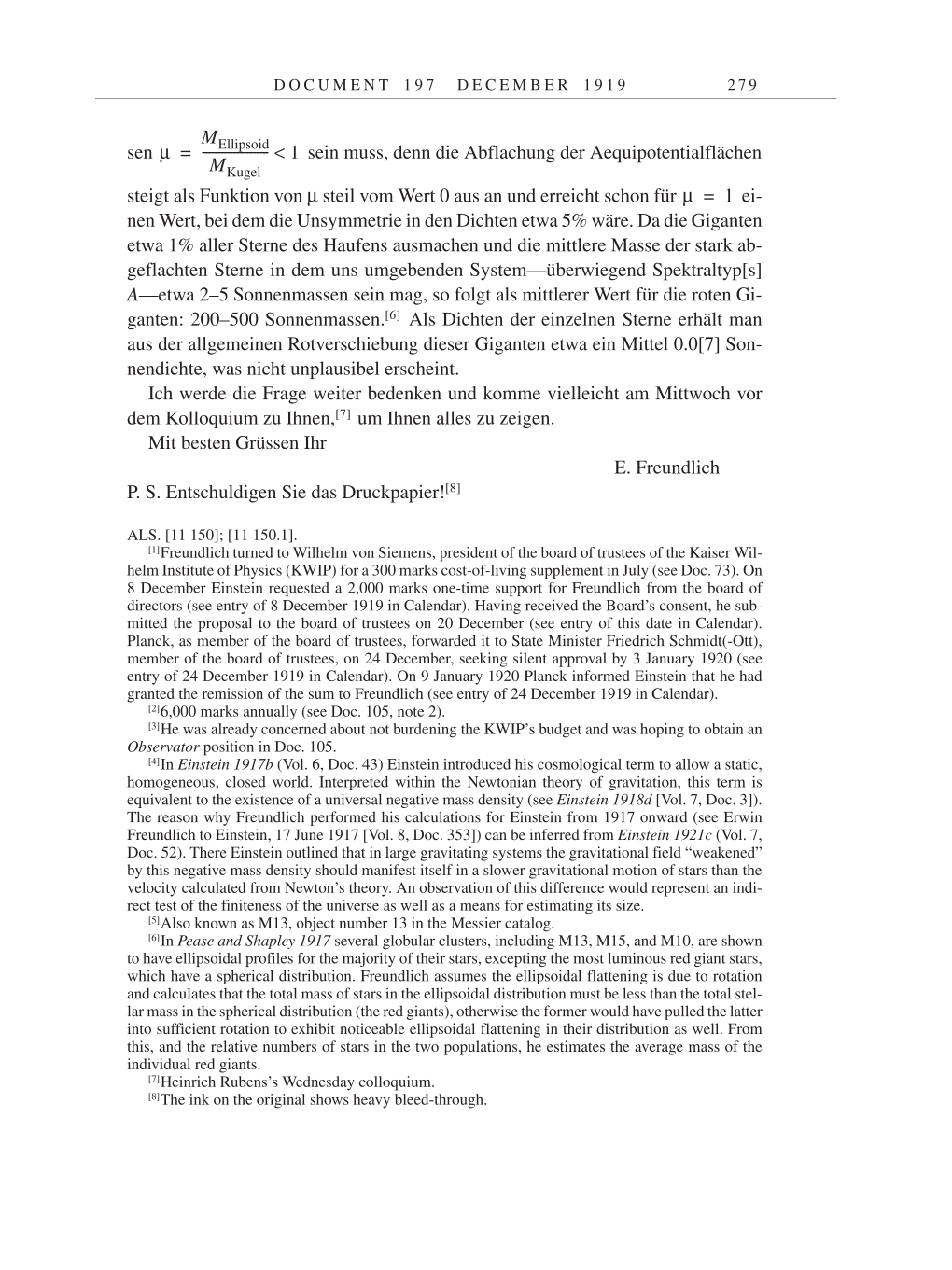D O C U M E N T 1 9 7 D E C E M B E R 1 9 1 9 2 7 9
sen sein muss, denn die Abflachung der Aequipotentialflächen
steigt als Funktion von μ steil vom Wert 0 aus an und erreicht schon für ei-
nen Wert, bei dem die Unsymmetrie in den Dichten etwa 5% wäre. Da die Giganten
etwa 1% aller Sterne des Haufens ausmachen und die mittlere Masse der stark ab-
geflachten Sterne in dem uns umgebenden System—überwiegend Spektraltyp[s]
A—etwa 2–5 Sonnenmassen sein mag, so folgt als mittlerer Wert für die roten Gi-
ganten: 200–500
Sonnenmassen.[6]
Als Dichten der einzelnen Sterne erhält man
aus der allgemeinen Rotverschiebung dieser Giganten etwa ein Mittel 0.0[7] Son-
nendichte, was nicht unplausibel erscheint.
Ich werde die Frage weiter bedenken und komme vielleicht am Mittwoch vor
dem Kolloquium zu
Ihnen,[7]
um Ihnen alles zu zeigen.
Mit besten Grüssen Ihr
E. Freundlich
P. S. Entschuldigen Sie das
Druckpapier![8]
ALS. [11 150]; [11 150.1].
[1]Freundlich turned to Wilhelm von Siemens, president of the board of trustees of the Kaiser Wil-
helm Institute of Physics (KWIP) for a 300 marks cost-of-living supplement in July (see Doc. 73). On
8 December Einstein requested a 2,000 marks one-time support for Freundlich from the board of
directors (see entry of 8 December 1919 in Calendar). Having received the Board’s consent, he sub-
mitted the proposal to the board of trustees on 20 December (see entry of this date in Calendar).
Planck, as member of the board of trustees, forwarded it to State Minister Friedrich Schmidt(-Ott),
member of the board of trustees, on 24 December, seeking silent approval by 3 January 1920 (see
entry of 24 December 1919 in Calendar). On 9 January 1920 Planck informed Einstein that he had
granted the remission of the sum to Freundlich (see entry of 24 December 1919 in Calendar).
[2]6,000 marks annually (see Doc. 105, note 2).
[3]He was already concerned about not burdening the KWIP’s budget and was hoping to obtain an
Observator position in Doc. 105.
[4]In Einstein 1917b (Vol. 6, Doc. 43) Einstein introduced his cosmological term to allow a static,
homogeneous, closed world. Interpreted within the Newtonian theory of gravitation, this term is
equivalent to the existence of a universal negative mass density (see Einstein 1918d [Vol. 7, Doc. 3]).
The reason why Freundlich performed his calculations for Einstein from 1917 onward (see Erwin
Freundlich to Einstein, 17 June 1917 [Vol. 8, Doc. 353]) can be inferred from Einstein 1921c (Vol. 7,
Doc. 52). There Einstein outlined that in large gravitating systems the gravitational field “weakened”
by this negative mass density should manifest itself in a slower gravitational motion of stars than the
velocity calculated from Newton’s theory. An observation of this difference would represent an indi-
rect test of the finiteness of the universe as well as a means for estimating its size.
[5]Also known as M13, object number 13 in the Messier catalog.
[6]In Pease and Shapley 1917 several globular clusters, including M13, M15, and M10, are shown
to have ellipsoidal profiles for the majority of their stars, excepting the most luminous red giant stars,
which have a spherical distribution. Freundlich assumes the ellipsoidal flattening is due to rotation
and calculates that the total mass of stars in the ellipsoidal distribution must be less than the total stel-
lar mass in the spherical distribution (the red giants), otherwise the former would have pulled the latter
into sufficient rotation to exhibit noticeable ellipsoidal flattening in their distribution as well. From
this, and the relative numbers of stars in the two populations, he estimates the average mass of the
individual red giants.
[7]Heinrich Rubens’s Wednesday colloquium.
[8]The ink on the original shows heavy bleed-through.
μ
MEllipsoid
MKugel
-------------------- - 1 =
μ 1 =
